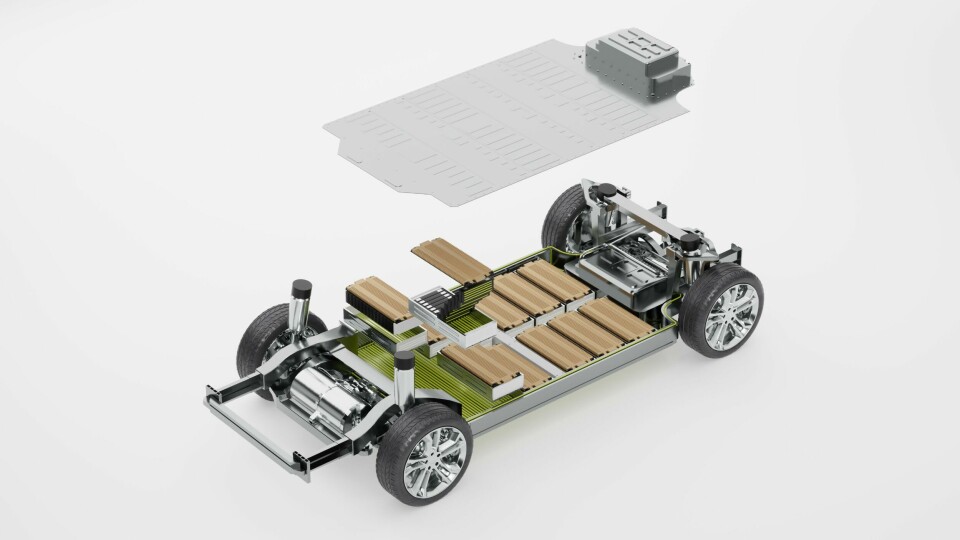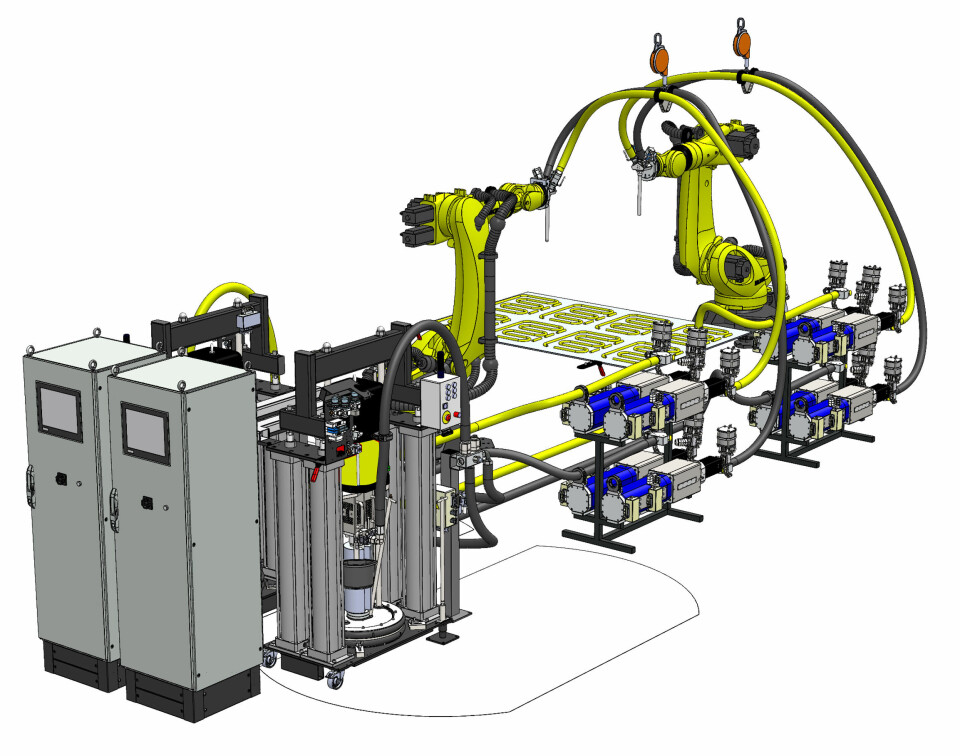SAMES’ solutions: precise assembly processes for battery packs
PARTNER CONTENT
This content was produced by Automotive Manufacturing Solutions in partnership with Sames
As the electric vehicle (EV) market grows, the need for efficient and safe battery pack assembly intensifies. Benoit Batllo from SAMES shares how the company tackles challenges in applying critical materials like dielectric coatings, fire protection coatings, and thermal conductive adhesives (TCAs)

Quality control in battery cell and pack production is challenging, with every aspect having to meet strict performance criteria. This extends to the specialist sealant, adhesive, thermal and conductive materials used and their application. These materials are critical to the safety and performance of the battery and their precise application is key to ensuring they perform as required. SAMES looks at the materials and battery applications, highlighting dispensing and dosing challenges and solutions.
The role of dielectric coatings and their application challenges
One of the key materials used in EV battery packs is dielectric coatings, which are critical for electrical insulation. However, their application requires precision and control. Batllo explained, “We must ensure a minimum thickness everywhere to provide proper insulation, but at the same time, we cannot afford to apply it on electrodes.” This makes the application process highly demanding.
In addition, managing material waste while optimising application efficiency is a constant challenge. “Controlling the thickness to minimise material waste and maintaining the optimal transfer ratio, even when electrostatic application is not possible, requires a high level of precision,” Batllo emphasised. This reflects how safety-critical processes like these must always be subject to rigorous quality control measures.

Battery fire protection coatings: Meeting high-volume demands
The application of battery fire protection (BFP) coatings is another major challenge. These coatings are designed to protect the battery from overheating and fire risks, but the volume required is significant, with up to six litres of material needed for a single battery pack. “The quantity to apply is huge, ranging from two to six litres per pack, and the cycle time can be as low as one minute per battery,” Batllo noted.
This need for high-volume application presents unique hurdles in ensuring both speed and precision. “The flow rate must reach up to eight litres per minute, so the dosing unit has to have a high capacity,” Batllo shared. Moreover, these coatings often involve two-component materials, which are difficult to handle due to their abrasiveness. To address this, SAMES developed advanced application guns that can be easily flushed between cycles, ensuring efficiency even under demanding conditions.
“We focus on designing high-capacity systems that can maintain the necessary flow rates while also ensuring that the application process remains precise”– Benoit Batllo, SAMES
Thermal conductive adhesives: Addressing the demands of thermal management
In EV battery packs, managing heat is essential to maintaining performance and safety, which is where thermal conductive adhesives (TCAs) and gap fillers come into play. These materials are applied between the battery modules and cooling devices to ensure proper thermal management. The challenge, as Batllo explained, lies in achieving the exact geometry and coverage. “We have to respect the bead geometry and section shape to ensure total coverage of the interface between the modules and the cooling device,” he said.
With the amount of material needed per battery pack reaching as much as 12 litres, the dosing units must be robust and capable of handling large volumes while maintaining accuracy. Batllo further elaborated, “The cycle time can be lower than one minute per battery, so the flow rate capacity must be as high as possible to decrease the number of robots needed for the task.” Like with BFP coatings, TCAs are often abrasive, and all components in the application system must be made from durable materials like carbide to withstand wear over time.
Accelerating production: Adapting to increased volumes
As the EV market expands, the demand for faster and more efficient battery production lines is growing. Currently, battery pack assembly lines operate at lower speeds than traditional automotive production lines, but that is changing as electric vehicle production ramps up. Batllo explained that the pace is increasing, particularly in response to companies like Tesla and some Chinese EV manufacturers pushing for higher volumes. “Most battery pack manufacturing lines are running at a slower pace than traditional car manufacturing lines, but we are seeing more requests to dimension robotic cells for full capacities, with some lines targeting up to 30 or even 60 batteries per minute,” Batllo shared.
To meet these demands, SAMES has had to develop systems capable of handling these increased volumes without sacrificing precision or quality. Batllo noted that achieving this balance is a key part of their technological innovation. “We focus on designing high-capacity systems that can maintain the necessary flow rates while also ensuring that the application process remains precise,” he explained.
The influence of material properties on application
The physical properties of the materials used in EV battery packs – such as viscosity, chemistry, and abrasiveness – significantly influence the application process. Heavier and more abrasive materials, like the ones used in gap fillers and TCAs, can cause increased wear on application systems. SAMES has addressed this challenge by using advanced materials for their equipment. “We use very hard materials, from chromium to ceramic for cylinders and piston rods, and carbide for valves,” Batllo revealed.
By designing systems to minimise restrictions and avoid sudden changes in direction, SAMES has managed to optimise flow and reduce wear. This is critical for ensuring that their equipment can meet the growing demands of EV battery production without needing frequent replacement or repair.

Application differences for battery cell types
Different types of battery cells – cylindrical, prismatic, and pouch – have specific material application requirements. As Batllo explained, “Pouch cells are assembled using pressure-sensitive adhesives, while prismatic cells are bonded with classical adhesives, and cylindrical cells are bonded to heat exchangers using TCAs and encapsulated with gap fillers.” These differences require tailored approaches to material application, making flexibility in manufacturing systems a necessity.
With the EV market evolving rapidly, SAMES must adapt its processes to accommodate new battery designs and technologies. Batllo acknowledged that the technologies in this field are still in flux, requiring agility from manufacturers. “Processes are evolving even within the time scale of a project deployment, so we must stay flexible,” he said.
Innovations in debonding for sustainability
As sustainability becomes a key focus in the EV industry, material suppliers are developing sealants and adhesives that can be easily de-bonded for recycling. Batllo mentioned that this is an area of ongoing development, with various solutions emerging, including debonding primers and mechanical or chemical processes. “For certain applications, butyl-based sealants are easy to remove and recycle, but for others, we are still exploring the best technology to meet customer specifications,” he noted.
SAMES’ focus is on analysing each case individually and determining the best method for debonding, whether it be through spraying, extrusion, or other techniques. This flexibility ensures that they can meet the sustainability goals of their customers while still delivering high-performance solutions.
SAMES’ technological advancements
To keep pace with the evolving demands of the EV market, SAMES has developed several new technologies. These include continuous dosing units (Infinitec), high-flow applicators (High Flow Valve), and abrasion-resistant pump systems (Ultimate). Batllo highlighted the importance of these innovations: “We’ve particularly focused on achieving the highest flow rates on the market while ensuring that our systems can resist the high abrasiveness of the materials used.”
In addition, for multi-component materials like BFP coatings, SAMES has introduced a flushable applicator that can operate sustainably over long periods. This ensures that even with complex materials, the application process remains efficient and reliable.
Find out more here


